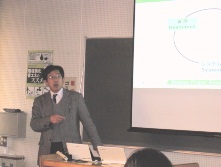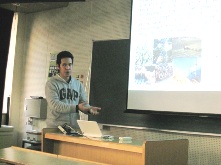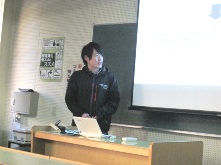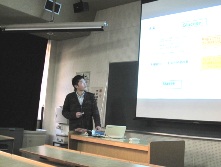On Mar 7, 2014, the 18th Biomass Evening Seminar was held at Graduate School of Engineering, Hiroshima University.
Biomass Project Research Center, Hiroshima University, and HOSTY Association are co-organizing the Hiroshima University Biomass Evening Seminar. This seminar covers topics from the fundamentals of biomass to the latest information so that it can contribute the activities on biomass in this district.
- Date & Time: Fri., Mar.7, 2014 16:20 - 17:50
- Place:
Engineering 110 Lecture Room, Higashi-Hiroshima Campus, Hiroshima University
[Program]
- Commentary:
Yukihiko MATSUMURA
Professor, Institute of Engineering, Hiroshima University
- Chair:
Machi KANNA
Assistant Professor, Institute of Engineering, Hiroshima University
- Lecture:
Yukihiko MATSUMURA(Takeshi DOZEN)
Professor, Institute of Engineering, Hiroshima University(M2 Student,Graduate School of Engineering)
"Pulverization biomass in a disk mill under hydrothermal condition"
|
Recently, biomass energy has attracted attention because of environmental problems. Especially, biomass which is non-edible biomass has attracted attention due to food shortage. Pretreatments such as pulverization or hydrothermal treatment are carried out as a first step to get ethanol from non-edible biomass, and these steps play important role via whole pretreatment steps. However effective pretreatments have never developed, so developing effective pretreatment method for non-edible biomass is really important. By now, effectiveness of using disk mill as a pretreatment is confirmed, and effectiveness of pulverization biomass under hydrothermal condition is also confirmed. However effective pretreatment methods have never been developed although these are considered as promising methods. And then, we thought combination of these two promising methods could be a great pretreatment method. Therefore pulverization biomass in a disk mill under hydrothermal condition was studied in this study because that kind of method was new and had never been studied. Purpose of this study is to build new reactor for new pretreatment method and elucidate characteristics of “pulverization biomass in a disk mill under hydrothermal condition” by using a new reactor. |
 |
- Lecture:
Thachanan SAMANMULUYA
D2 Student,Graduate School of Engineering, Hiroshima University
"Gasification Characteristics of Glycine and Alanine in Supercritical Water"
|
Alanine solution (1.0−3.0 wt%) was gasified in supercritical water using a tubular reactor at temperature of 500 to 650 C and pressure of 25 MPa for residence time of 94-119 s. The identification and quantification of gaseous product were conducted by gas chromatography (GC) and total organic carbon (TOC) in the aqueous phase was also determined. Based on the experimental results, the carbon gasification efficiency was calculated, and reaction rate parameters were determined assuming the first-order reaction. High temperature led to high carbon gasification efficiency, indicating the reaction rate constant following the Arrhenius equation. |
 |
- Lecture:
Hitoshi KAWASAKI
B4 Student,Faculty of Engineering, Hiroshima University
"Solubilization behavior of cellulose in hydrothermal pretreatment"
|
In the ethanol production process from lignocellulosic biomass, the hydrothermal pretreatment is an important preprocessing for conducting the enzymatic saccharification treatment, and controlling the solubilization of cellulose having a crystal structure under hydrothermal conditions is expected to be effective for the rapid enzymatic saccharification. The aim of this study is to confirm the solubilization behavior of cellulose solubilized in hot compressed water. WS yield increased exponentially with temperature, 2.5 g/L of total organic carbon was achieved at 300C. |
 |
- Lecture:
Yoshiki AKEYAMA
B4 Student,Faculty of Engineering, Hiroshima University
"Kinetic analysis of supercritical water gasification of acetic acid"
|
Glucose is gasified via a lot of intermediate products in supercritical water. Organic acids such as acetic acid may be the rate-limiting step of glucose gasification because these are relatively stable in supercritical water. So, it is important to reveal the decomposition and gasification property of organic acids. In this study, we conducted experiment using acetic acid which is low molecular and stable. We decided the rate reaction of acetic acid gasification experimentally, in order to investigate whether acetic acid is the rate-limiting step of glucose gasification and discussed the roles of acetic acid on glucose gasification in supercritical water. |
 |
[Inquiries about this article]
Graduate School of Engineering, Hiroshima University
Y.NAKASHIMA
Mail: y4naka [AT] hiroshima-u.ac.jp
(Please replace [AT] with @)

 Home
Home